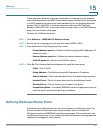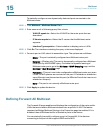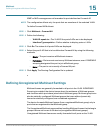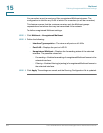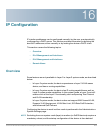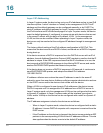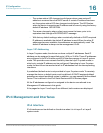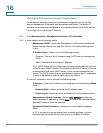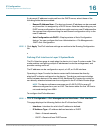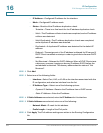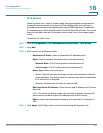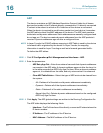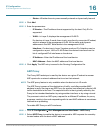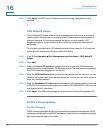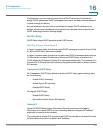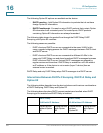
IP Configuration
IPv4 Management and Interfaces
Cisco Small Business 300 Series Managed Switch Administration Guide 258
16
If a dynamic IP address is retrieved from the DHCP server, select those of the
following fields that are enabled:
• Renew IP Address Now—The device dynamic IP address can be renewed
any time after it is assigned by a DHCP server. Note that depending on your
DHCP server configuration, the device might receive a new IP address after
the renewal that requires setting the web-based configuration utility to the
new IP address.
• Auto Configuration via DHCP—Displays status of Auto Configuration
feature. You can configure this from
Administration
>
File Management
>
DHCP Auto Configuration
.
STEP 3 Click Apply. The IPv4 interface settings are written to the Running Configuration
file.
Defining IPv4 Interface in Layer 3 System Mode
The IPv4 Interface page is used when the device is in Layer 3 system mode. This
mode enables configuring multiple IP addresses for device management, and
provides routing services.
The IP address can be configured on a port, a LAG, or VLAN interface.
Operating in Layer 3 mode, the device routes traffic between the directly-
attached IP subnets configured on the device. The device continues to bridge
traffic between devices in the same VLAN. Additional IPv4 routes for routing to
non-directly attached subnets can be configured in the IPv4 Static Routes page.
NOTE The device software consumes one VLAN ID (VID) for every IP
address configured on a port or LAG. The device takes the first VID that is
not used starting from 4094.
To configure the IPv4 addresses:
STEP 1 Click IP Configuration > IPv4 Management and Interfaces > IPv4 Interface.
This page displays the following fields in the IPv4 Interface Table:
• Interface—Interface for which the IP address is defined.
• IP Address Type—IP address defined as static or DHCP.
- Static—Entered manually.
- DHCP—Received from DHCP server.



